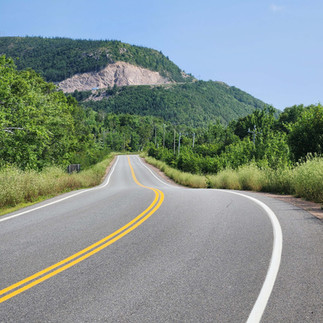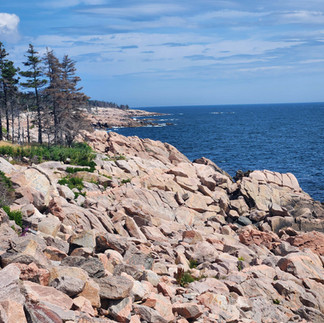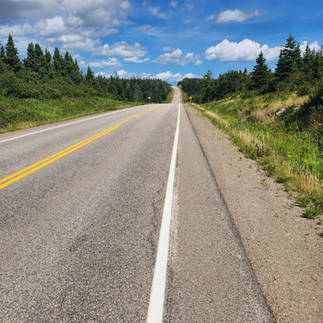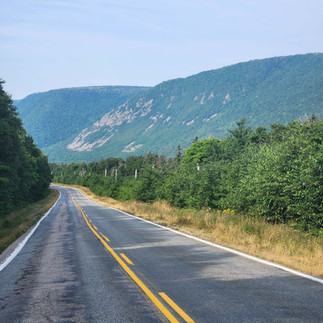Canada Part 3: Cape Breton
- otomola
- Aug 10, 2024
- 14 min read

Monday, August 5, 2024
Today is Day Six on Cape Breton. I have spent my nights at campgrounds in Cape Breton Highlands National Park: three at Ingonish Campground, two at Broad Cove, and one at Cheticamp, where I will stay tonight as well. Overall, today is Day 19 on this trip. Canada has been quite to my liking, so much so that I am thinking seriously about spending the summer here next year. I could easily spend a month in Cape Breton Highlands NP, a month in Prince Edward Island, and a month in New Foundland. A couple I met at Broad Cove told me a month would not be enough to do New Foundland, but that I would still see a lot. I am told it is beautiful throughout New Brunswick, too, which stretches far north. Time will tell.
Before writing about Cape Breton, I’ll mention that my time at Murray Beach in New Brunswick and at the three campgrounds on Prince Edward Island has been fantastic. Being here in Cape Breton only adds to the good I have seen and experienced overall. Why is this the case?
Is it the people I have met? I would categorize “meeting people” in two main ways. One is the simple, daily activities, routines kind of, talking with people working at the grocery store, in the parks, or in other practical matters. The other way is interacting with others who are camping or traveling. In both situations there has been a spirit of welcoming, and in the latter, there have been robust conversations.
Is it the fact that the population density is rather low? There are very few big towns. I’m hesitant to say there are any big towns, though in terms of supplies and things one needs, shopping, restaurants, as well as cultural activities, there is plenty. The largest city on PEI has, Charlottetown, has 39,000 population. Other than Halifax, which has around 400,000 people, everything is small scale. One gas station per locality is often the case, for example, and often there are no gas stations or markets. There are little “villages” that are communities, but they have no businesses at all, no gas, no markets, no stores of any kind. It is country, nature, lots of open grassland, farms, forests, etc. There is a lot of natural space.
By the way, gas prices are set by the government in Nova Scotia. It’s very different from the US, where the prices can fluctuate widely from station to station. The places I have been driving all over are all within a couple pennies of each other due to this reason. That said, gas is more expensive here. It’s sold by the liter, and I paid $1.77 per liter this week. (A liter is 1.057 quarts, a gallon is 3.8 liters. A gallon of gas a $1.77 costs about $6.70 Canadian dollars. Last I checked, the exchange rate was $1.00 US currency was worth $1.39 Canadian. So, it comes out to about $4.80 a gallon in US dollars.
Anyway, there is great beauty here. I have been surrounded by and immersed in nature. I have not been a “beach person” in the sense of making trips to beaches, spending time at them, prioritizing them in any way over the last forty or so years. In my youth, teens, and 20s I did involve the beach to a good degree in my life. I would go to Gloucester, MA fairly often. I loved it. I enjoyed it greatly. That all changed when I went west for the first time in 1984. I did not stop loving the beach, but the mountains and the desert became my priority. I loved it even more.
There is some sensation about being here that is satisfying, exhilarating and peaceful simultaneously.
Ingonish Campground was my first stop in Cape Breton. In general, the campsites here are close together with very little privacy. When I arrived, I had two adjacent neighbors. One neighbor was a couple from Ottawa. They had driven 16 hours the day before to arrive here on what was a relatively short trip. They had their tent set up right on some unseen border line with my site. He greeted me right away, introducing himself and asking if I thought the tent would be too close. “Not for me,” I said. His name was Andrew, her name was Mindy. They were in their late 20s-early 30s, very friendly. We talked daily to some degree. They were gone most of the day, off exploring. I know one day they went on a whale-watch boat and say two whales up very close.
The other campsite had three cars (the rules state one car per site) and five guys. One guy, Blenus, was in his 40s, the other four were in their younger 20s. I talked with them at their site, beer cans in their hands, all very curious about my van and travels. They had two tents and a tent-topped pickup truck. It turns out they had more friends at other sites, too. They were very friendly, too. They were not rowdy drinkers. Well, at least not while I interacted with them.
They were all from Cape Breton and loved it her\e. One guy, his name was Chase, told me the beauty of the area was unsurpassed, though he sometimes takes it for granted. He said if he went to Connecticut (he pronounced it Connect-i-cut, which I find others here do as well. Like the way I pronounce Newfoundland as New Foundland, as two words, which is incorrect, too. The accent is on the new in the word, so I have noticed.)
The first night there, I went right off to sleep around 8:30. I did not hear any noise during the night. The next day, I went for a bike ride. When I came back, the five guys were gone. In fact, a good deal of the campground had checked out, lots of empty sites. But I crossed paths with Blenus later, towards the evening, while I was out for a walk. He said they were back and had a couple different sites. He told me he caught flack from the park ranger when reserving a site for another night. He told me about some adventures that had apparently taken place after I went to bed the previous night. The group had met at one of their other friends’ campsite and had a campfire. When those friends went to bed, Chase and the group decided to have a new campfire in an unoccupied campsite. This apparently bothered a couple next to that site, who called the campground after-hours phone number. That ended the second campfire. But, not to give up, the group moved to a community fire-ring located at the other end of the campground, probably about 150 yards from the couple who made the call, and started another campfire. But the couple who made the call somehow found out about this and called the Canadian Mounted Police (which had a station about five miles down Highway 30.) That put an end to the third campfire.
The beach at Ingonish is about half-mile walk. I went there in the evenings on my three days there. There were very few people there. The entire length of the beach, about a mile wide, is sandy with a border of stones between the sand and the parking lot. The stones are piled high, up to ten feet in some places, and twenty to thirty yards wide. It makes me think of a dam. It looks as if the stones have been placed there, but there are so many also seems impossible. Looking at the stones, they seem as if they could be an artist’s installation. They have a mesmerizing beauty. They are all worn smooth by the water, in a variety of sizes, rounded shapes, and colors.
I talked with a young woman on one of my beach visits, Kiara. She came up to me with searching eyes because … she believed she had car trouble. She asked me if I knew cars. Not much, I said. She explained that something was leaking under the engine area. She had run over the concrete curb in a parking space, and she feared she had damaged something. When she looked, there was this leak. We looked under the car as she showed me the drip. I asked her to back up the car so we could determine if it was oil or water based. I rubbed some of the fluid in my fingers, it was not slippery, and based on where it was dripping, I guessed it was condensation from the air conditioning, just like where it would be with my Honda. I confirmed she had been using the AC when she parked. She thought maybe she should find a mechanic. I suggested to her that, it being around 8PM, she probably would not find a mechanic, and that there was a very good chance it was the AC, and that maybe, having just run over the curb, she felt there must be something wrong, but in fact there wasn’t.
She was visiting from Quebec, she told me, and then she said is really visiting from Germany. She has been here working with elderly who have disabilities. It sounded like an internship type of thing. She was almost finished, and she was going to move on to British Columbia for a few weeks of vacation before maybe returning to Germany. She was going to meet her Mom in BC and was very happy about that. I loved listening to her accent.
On my second night at Ingonish, I took my walk towards a landform known as Middle Head. It is a piece of land that reaches out into the ocean for nearly three miles. On this land is Keltic Lodge. As I walked past it, I noticed a restaurant, Arduaine. Spur of the moment, I decided to eat there. I had a great dinner of fried fresh haddock with french fries while sitting out on their patio overlooking South Ingonish Bay. It felt magical. I went out the next morning and did the hike to the end of Middle Head, too! It was also fantastic. And on that hike, I met a couple who asked where I was from. “Connecticut,” I told them. He said, “I lived in Waterbury for thirty years as a delivery person.” “What did you deliver?” I asked him. “Babies!” he said. He was a doctor, retired now. We talked a few minutes and I moved on. At the end of the hike, another couple was standing talking with a ranger. The woman was wearing a Groovy Goat t-shirt. I told her I had seen the Groovy Goat and stopped to take a photo of the sign the day before. We got talking and the guy mentioned he lived in Norwalk for two years, many years ago. I said, “That’s amazing. I just talked with a couple that had lived in Waterbury for thirty years!” “Oh, that’s my brother, the doctor. Did he tell you his delivery story?”
Some pics from Ingonish ...
Later, I stopped in the Groovy Goat, looking to maybe buy one of those T-shirts, but they did not have any in a color I liked. But they had a little farm out back. I went out and visited with the goats. There must have been 15-20 of them, as well as three sheep, two donkeys, and a couple ducks. They used goat milk to produce a line of all natural soaps and skin care products. That was the business of the Groovy Goat, a very down to Earth place.

From Ingonish, I went to Broad Cove. It had been sunny and hot for the past four days, and I was so happy to discover that my site was shaded! It made it much easier to be in the van, keeping things cooler. I met a couple from Sydney, which is on the other side of Cape Breton. They come to Broad Cove annually and arrived same day as me. They were staying ten days. They were very friendly and welcoming, and they gave me lots of information about restaurants and places to visit, including Aucoin Bakery in Cheticamp, where I went today for lunch and an apple pie!
The beach at Broad Cove is amazing. After a bike ride on Saturday, I came back and walked down there with my chair. It is possibly the most beautiful beach I have ever experienced. It is over a mile long, flanked on both sides by cliffs rising over 200 feet high. The beach is sandy, but the sand at water’s edge, I learned as I walked into the waves, is heavily populated with small stones, penny sized or smaller, round and smooth in shape and texture.
The waves at both Ingonish and Broad Cove were not large, ranging from half a foot to occasionally two feet. They crest and crash right up close to the water’s edge. There were no waves cresting and crashing out deeper. When they do crash, on the way out they create a strong undertow, carrying sand and those little round stones with them. I “floated” in this area for about ten minutes. Laying down and letting my body rest. As the waves rolled in and the undertow rushed out, one second I was lifted in water 1-2 feet deep, a few seconds later I was dropped onto the sand, the water was only inches deep. I floated back and forth; my body was pushed forward then dragged out. Twisting and turning in a fun, unpredictable way. My bike shorts, which double as my bathing suit, caught lots of sand in them from the rushing water.
I could see myself spending two weeks here. I am seriously considering a three-month trip back to the Maritime Provinces next summer, June, July, and August.
Okay, bike riding. I did two rides from Ingonish. On one, I rode south on RT 30 for fifteen miles. This meant climbing over Cape Smokey, then down the other side as far as Wreck Cove. Cape Smokey rises to about 900 feet with breath-taking views of the Atlantic coastline. It is a gradual five mile, climb on one side, with a much steeper climb of about one and a half miles on the return side. The next day I rode sixteen miles north to Neils Harbor. Although there were no long climbs, there were plenty of short rolling hills, such that total climbing for the two rides was very similar, one day 2500’, the next 2300’.
On the ride back from Neils Harbor, I crossed paths with four women on a bike tour. Three of them had e-bikes, one had a regular bike. One of them told me they wrote a check, meaning they were on a guided, fully supported tour, with meals provided by a sag wagon and hotel accommodations at night. They were riding the Cabot Trail (the famous trail that runs the perimeter of Cape Breton) that passes through the national park, from Cheticamp to Ingonish. The Cabot Trail extends outside of the park as well. These four were part of a group of fourteen, twelve women and two men. They were from all over the United States.
I did two more rides in the park. On Saturday, I rode from Broad Cove to the top of North Mountain, then back. It was a hard ride, a hot and humid day, and very windy on the last nine miles along the coast. The first section, and hence the last section coming back, was part of the ride I did the other day. It has great views of the rocky coast with many scenic pull-offs. It is rolling hills. Once past Neils Harbor, there is a five mile climb with a 6% grade, according to a sign. I did not find it to be steep or difficult at all. It had a good road surface. Basically, when the road is in the park, it is a good surface. When RT 30 exits the park, the road needs work. There are sections where the road leaves the park and passes through the local village, such in Ingonish and Cape North, and it is narrow and kind of bumpy. Then when it crosses back into the national park, the road is wider with a marked shoulder and it is a nicely paved surface. After the five-mile climb, the road descends into Cape North. There is a steep hill rising from the lowest part, which is near sea level. Then it is flat through forested land for about six miles, where the climb up North Mountain begins.
I felt good all the way to base of North Mountain. I felt the “hard” part began as a direct result of the heat. It took just over two hours to arrive at the base, and I had drank 33 ounces of fluids. It was 82 degrees at that point, and it felt hotter, which might have meant I was feeling it. I estimated I only had a few more miles to go before turning around. There was a sign saying there were curves the next 2K, and this is where it became very steep. It is a beautiful road, double digit gradient the entire 2K, short switchbacks wandering above a deep canyon covered with trees. It’s another engineering marvel, how it climbs through the rugged backcountry.
I stopped to take photos shortly after that 2K sign, and it was then I felt the heat. It’s an odd thing, but I felt bad when I stopped, felt much better when I was back on the bike, working hard, grades of 10-14%. Several times, when reaching one of those turns, you look up as you come around the corner, and a new stretch of road greets you, rising higher. More climbing, more singing “almost there!”
After the 2K, the gradient relented to about 4% for a final mile or so. It looks and feels almost flat. It looks flat from the perspective of the road, all around, 360 degrees, though after that last mile the road starts to go downhill. I turned around there. It took about forty-five minutes to do the last three miles! I drank another twenty-ounce bottle along the way!
The ride down was fast and exhilarating. I braked several times when I hot 40 mph. The view coming down goes by so fast, but it was wonderful. It gave me a better perspective of the depth of the canyon adjacent to the south side of the road.
On my way down the hill, I passed three guys riding together up the hill, before the steep part. They had the same colors, red, white, and blue, same jersey. As I rode the seven miles back to Cape North, one of them caught up with me. He had jersey that said Nova Scotia on the back. I think it was a team jersey. He also had a rear disk wheel. He asked about my ride, I told him I was doing an out and back from Broad Cove to the top of that climb. I asked about his jersey, was it for a team, was out doing a training ride? He said yes, doing a training ride, and he had just returned from an “international stage race.” He did not seem to want to specify. The Tour de France had ended the week before. Maybe he had been there? We talked a couple minutes. He was heading back he hoped to catch the ending of the Olympic Road Race. I asked if he lived around here. He said “yea, kind of …” then he said have a nice ride and took off. Another guy passed me later, same jersey, before I reached town. Then a little closer to town, five guys with white and red jerseys, went riding in the other direction. Red and white are the colors of the Canadian flag. So, it might be the case that Canadian cycling teams use this area for training.
Photos from four days of cycling ...
Having finished my third and last Gatorade bottle, I stopped in town and replenished my fluids, two new bottles. I had about nineteen miles to go back to the campground. It was now 86 degrees. I had one medium sized climb (about three miles averaging 8%) and several short steep climbs along the coast. I could feel the heat, and reacted accordingly, just taking my time, slow and easy, no hurry to be anywhere. I arrived back at the campground with a total ride time of 5h 5m. It was a great ride.
I had planned to take Sunday off from riding, then do a long ride on Monday from Cheticamp to the top of North Mountain, this time coming up the north side. But the weather forecast was for rain all day Monday, so I opted to do part of that ride on Sunday, and out and back from Cheticamp to the top of Camp Mountain. The road is one of the most scenic I have ever ridden in that there are about six miles along the coast on a series of short but very steep hills. After those six miles comes the climb up Camp Mountain, which tops out at 455 meters according to the sign, almost 1,450 feet.
Monday, I rested. I went to Aucoin Bakery and had a great lunch and took home an apple pie to enjoy over the next few days. Due to that rain, I did not ride one section of my planned riding within the park. The total distance I planned to ride, from Wreck Harbor to Cheticamp, was about 80 miles, and since I was riding out and back each day, the total would have been 160 miles. I did about 140 miles of that, but I missed two big climbs, the north side of North Mountain and McKenzie Mountain just outside of Pleasant Bay. Next time.































































Comments